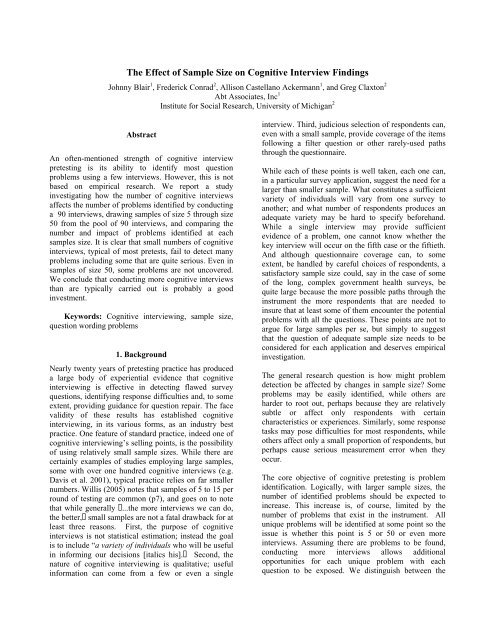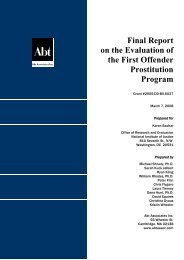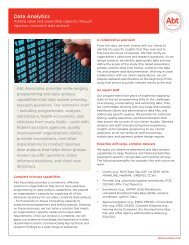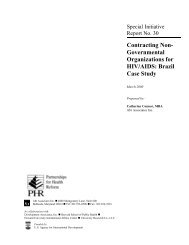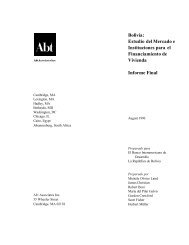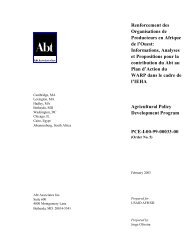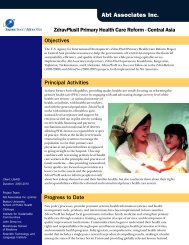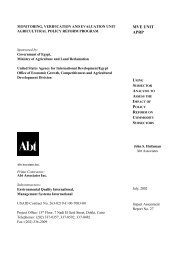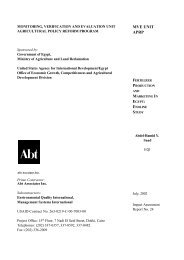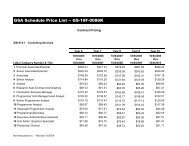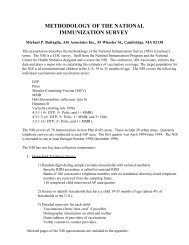The Effect of Sample Size on Cognitive Interview ... - Abt Associates
The Effect of Sample Size on Cognitive Interview ... - Abt Associates
The Effect of Sample Size on Cognitive Interview ... - Abt Associates
You also want an ePaper? Increase the reach of your titles
YUMPU automatically turns print PDFs into web optimized ePapers that Google loves.
<str<strong>on</strong>g>The</str<strong>on</strong>g> <str<strong>on</strong>g>Effect</str<strong>on</strong>g> <str<strong>on</strong>g>of</str<strong>on</strong>g> <str<strong>on</strong>g>Sample</str<strong>on</strong>g> <str<strong>on</strong>g>Size</str<strong>on</strong>g> <strong>on</strong> <strong>Cognitive</strong> <strong>Interview</strong> Findings<br />
Johnny Blair 1 , Frederick C<strong>on</strong>rad 2 , Allis<strong>on</strong> Castellano Ackermann 1 , and Greg Claxt<strong>on</strong> 2<br />
<strong>Abt</strong> <strong>Associates</strong>, Inc 1<br />
Institute for Social Research, University <str<strong>on</strong>g>of</str<strong>on</strong>g> Michigan 2<br />
Abstract<br />
An <str<strong>on</strong>g>of</str<strong>on</strong>g>ten-menti<strong>on</strong>ed strength <str<strong>on</strong>g>of</str<strong>on</strong>g> cognitive interview<br />
pretesting is its ability to identify most questi<strong>on</strong><br />
problems using a few interviews. However, this is not<br />
based <strong>on</strong> empirical research. We report a study<br />
investigating how the number <str<strong>on</strong>g>of</str<strong>on</strong>g> cognitive interviews<br />
affects the number <str<strong>on</strong>g>of</str<strong>on</strong>g> problems identified by c<strong>on</strong>ducting<br />
a 90 interviews, drawing samples <str<strong>on</strong>g>of</str<strong>on</strong>g> size 5 through size<br />
50 from the pool <str<strong>on</strong>g>of</str<strong>on</strong>g> 90 interviews, and comparing the<br />
number and impact <str<strong>on</strong>g>of</str<strong>on</strong>g> problems identified at each<br />
samples size. It is clear that small numbers <str<strong>on</strong>g>of</str<strong>on</strong>g> cognitive<br />
interviews, typical <str<strong>on</strong>g>of</str<strong>on</strong>g> most pretests, fail to detect many<br />
problems including some that are quite serious. Even in<br />
samples <str<strong>on</strong>g>of</str<strong>on</strong>g> size 50, some problems are not uncovered.<br />
We c<strong>on</strong>clude that c<strong>on</strong>ducting more cognitive interviews<br />
than are typically carried out is probably a good<br />
investment.<br />
Keywords: <strong>Cognitive</strong> interviewing, sample size,<br />
questi<strong>on</strong> wording problems<br />
1. Background<br />
Nearly twenty years <str<strong>on</strong>g>of</str<strong>on</strong>g> pretesting practice has produced<br />
a large body <str<strong>on</strong>g>of</str<strong>on</strong>g> experiential evidence that cognitive<br />
interviewing is effective in detecting flawed survey<br />
questi<strong>on</strong>s, identifying resp<strong>on</strong>se difficulties and, to some<br />
extent, providing guidance for questi<strong>on</strong> repair. <str<strong>on</strong>g>The</str<strong>on</strong>g> face<br />
validity <str<strong>on</strong>g>of</str<strong>on</strong>g> these results has established cognitive<br />
interviewing, in its various forms, as an industry best<br />
practice. One feature <str<strong>on</strong>g>of</str<strong>on</strong>g> standard practice, indeed <strong>on</strong>e <str<strong>on</strong>g>of</str<strong>on</strong>g><br />
cognitive interviewing’s selling points, is the possibility<br />
<str<strong>on</strong>g>of</str<strong>on</strong>g> using relatively small sample sizes. While there are<br />
certainly examples <str<strong>on</strong>g>of</str<strong>on</strong>g> studies employing large samples,<br />
some with over <strong>on</strong>e hundred cognitive interviews (e.g.<br />
Davis et al. 2001), typical practice relies <strong>on</strong> far smaller<br />
numbers. Willis (2005) notes that samples <str<strong>on</strong>g>of</str<strong>on</strong>g> 5 to 15 per<br />
round <str<strong>on</strong>g>of</str<strong>on</strong>g> testing are comm<strong>on</strong> (p7), and goes <strong>on</strong> to note<br />
that while generally ...the more interviews we can do,<br />
the better, small samples are not a fatal drawback for at<br />
least three reas<strong>on</strong>s. First, the purpose <str<strong>on</strong>g>of</str<strong>on</strong>g> cognitive<br />
interviews is not statistical estimati<strong>on</strong>; instead the goal<br />
is to include “a variety <str<strong>on</strong>g>of</str<strong>on</strong>g> individuals who will be useful<br />
in informing our decisi<strong>on</strong>s [italics his]. Sec<strong>on</strong>d, the<br />
nature <str<strong>on</strong>g>of</str<strong>on</strong>g> cognitive interviewing is qualitative; useful<br />
informati<strong>on</strong> can come from a few or even a single<br />
interview. Third, judicious selecti<strong>on</strong> <str<strong>on</strong>g>of</str<strong>on</strong>g> resp<strong>on</strong>dents can,<br />
even with a small sample, provide coverage <str<strong>on</strong>g>of</str<strong>on</strong>g> the items<br />
following a filter questi<strong>on</strong> or other rarely-used paths<br />
through the questi<strong>on</strong>naire.<br />
While each <str<strong>on</strong>g>of</str<strong>on</strong>g> these points is well taken, each <strong>on</strong>e can,<br />
in a particular survey applicati<strong>on</strong>, suggest the need for a<br />
larger than smaller sample. What c<strong>on</strong>stitutes a sufficient<br />
variety <str<strong>on</strong>g>of</str<strong>on</strong>g> individuals will vary from <strong>on</strong>e survey to<br />
another; and what number <str<strong>on</strong>g>of</str<strong>on</strong>g> resp<strong>on</strong>dents produces an<br />
adequate variety may be hard to specify beforehand.<br />
While a single interview may provide sufficient<br />
evidence <str<strong>on</strong>g>of</str<strong>on</strong>g> a problem, <strong>on</strong>e cannot know whether the<br />
key interview will occur <strong>on</strong> the fifth case or the fiftieth.<br />
And although questi<strong>on</strong>naire coverage can, to some<br />
extent, be handled by careful choices <str<strong>on</strong>g>of</str<strong>on</strong>g> resp<strong>on</strong>dents, a<br />
satisfactory sample size could, say in the case <str<strong>on</strong>g>of</str<strong>on</strong>g> some<br />
<str<strong>on</strong>g>of</str<strong>on</strong>g> the l<strong>on</strong>g, complex government health surveys, be<br />
quite large because the more possible paths through the<br />
instrument the more resp<strong>on</strong>dents that are needed to<br />
insure that at least some <str<strong>on</strong>g>of</str<strong>on</strong>g> them encounter the potential<br />
problems with all the questi<strong>on</strong>s. <str<strong>on</strong>g>The</str<strong>on</strong>g>se points are not to<br />
argue for large samples per se, but simply to suggest<br />
that the questi<strong>on</strong> <str<strong>on</strong>g>of</str<strong>on</strong>g> adequate sample size needs to be<br />
c<strong>on</strong>sidered for each applicati<strong>on</strong> and deserves empirical<br />
investigati<strong>on</strong>.<br />
<str<strong>on</strong>g>The</str<strong>on</strong>g> general research questi<strong>on</strong> is how might problem<br />
detecti<strong>on</strong> be affected by changes in sample size Some<br />
problems may be easily identified, while others are<br />
harder to root out, perhaps because they are relatively<br />
subtle or affect <strong>on</strong>ly resp<strong>on</strong>dents with certain<br />
characteristics or experiences. Similarly, some resp<strong>on</strong>se<br />
tasks may pose difficulties for most resp<strong>on</strong>dents, while<br />
others affect <strong>on</strong>ly a small proporti<strong>on</strong> <str<strong>on</strong>g>of</str<strong>on</strong>g> resp<strong>on</strong>dents, but<br />
perhaps cause serious measurement error when they<br />
occur.<br />
<str<strong>on</strong>g>The</str<strong>on</strong>g> core objective <str<strong>on</strong>g>of</str<strong>on</strong>g> cognitive pretesting is problem<br />
identificati<strong>on</strong>. Logically, with larger sample sizes, the<br />
number <str<strong>on</strong>g>of</str<strong>on</strong>g> identified problems should be expected to<br />
increase. This increase is, <str<strong>on</strong>g>of</str<strong>on</strong>g> course, limited by the<br />
number <str<strong>on</strong>g>of</str<strong>on</strong>g> problems that exist in the instrument. All<br />
unique problems will be identified at some point so the<br />
issue is whether this point is 5 or 50 or even more<br />
interviews. Assuming there are problems to be found,<br />
c<strong>on</strong>ducting more interviews allows additi<strong>on</strong>al<br />
opportunities for each unique problem with each<br />
questi<strong>on</strong> to be exposed. We distinguish between the
number <str<strong>on</strong>g>of</str<strong>on</strong>g> unique or different problems and the total<br />
number <str<strong>on</strong>g>of</str<strong>on</strong>g> instances <str<strong>on</strong>g>of</str<strong>on</strong>g> each unique problem, <str<strong>on</strong>g>of</str<strong>on</strong>g> which<br />
there are almost certainly more.<br />
<strong>Cognitive</strong> interviewing shares some techniques, such as<br />
thinking aloud, and goals, such as problem detecti<strong>on</strong>,<br />
with the field <str<strong>on</strong>g>of</str<strong>on</strong>g> usability testing, in which the object is<br />
to empirically determine the kinds <str<strong>on</strong>g>of</str<strong>on</strong>g> errors that people<br />
make in using particular interfaces to s<str<strong>on</strong>g>of</str<strong>on</strong>g>tware systems.<br />
<str<strong>on</strong>g>The</str<strong>on</strong>g> issue <str<strong>on</strong>g>of</str<strong>on</strong>g> sample size in usability testing has been<br />
examined from a few perspectives (e.g. product testing<br />
and user interface tests), but the results uniformly come<br />
down <strong>on</strong> the side <str<strong>on</strong>g>of</str<strong>on</strong>g> small samples being sufficient.<br />
Rubin (1994) suggests that if the goal is to “generalize<br />
to your specific target populati<strong>on</strong>,” then a large enough<br />
sample <str<strong>on</strong>g>of</str<strong>on</strong>g> participants is needed to support the planned<br />
analyses. If, as is more comm<strong>on</strong>, “you are simply<br />
attempting to expose as many usability problems as<br />
possible in the shortest amount <str<strong>on</strong>g>of</str<strong>on</strong>g> time, then test at least<br />
four to five participants (p128).” Hix and Harts<strong>on</strong><br />
(1993) suggest that “....three participants per user class<br />
is [<str<strong>on</strong>g>of</str<strong>on</strong>g>ten] the most cost-effective number (p291).”<br />
Both <str<strong>on</strong>g>of</str<strong>on</strong>g> these recommendati<strong>on</strong>s come with caveats<br />
about careful selecti<strong>on</strong> <str<strong>on</strong>g>of</str<strong>on</strong>g> “representative users.”<br />
Nielsen and Landauer (1993) take a more rigorous<br />
approach, in which they estimate the number <str<strong>on</strong>g>of</str<strong>on</strong>g><br />
problems remaining to be detected based <strong>on</strong> the number<br />
detected in early test iterati<strong>on</strong>s. <str<strong>on</strong>g>The</str<strong>on</strong>g>y also used<br />
judgments <str<strong>on</strong>g>of</str<strong>on</strong>g> expert evaluators to identify problems that<br />
might potentially be encountered by test users,<br />
analogous to expert panel assessment <str<strong>on</strong>g>of</str<strong>on</strong>g> survey<br />
instruments and actual pretest resp<strong>on</strong>dents. <str<strong>on</strong>g>The</str<strong>on</strong>g>y<br />
recommended (based <strong>on</strong> a number <str<strong>on</strong>g>of</str<strong>on</strong>g> empirical criteria)<br />
testing between 7 (designated “Small”) and 20<br />
(designated “Very large”) users. In more recent writing,<br />
Neils<strong>on</strong> has advocated testing 20 users when collecting<br />
quantitative usability data (2006).<br />
Perhaps the usability methodology has less<strong>on</strong>s for<br />
survey instrument testing. However, there are enough<br />
differences between user interfaces and survey<br />
questi<strong>on</strong>naires and between users and resp<strong>on</strong>dents that<br />
these less<strong>on</strong>s may be <str<strong>on</strong>g>of</str<strong>on</strong>g> limited value. First, the range <str<strong>on</strong>g>of</str<strong>on</strong>g><br />
intended users <str<strong>on</strong>g>of</str<strong>on</strong>g> an interface can certainly be wide, but<br />
is probably seldom as varied as sample for a nati<strong>on</strong>al<br />
general populati<strong>on</strong> survey. To the extent that potential<br />
problems may differ by type <str<strong>on</strong>g>of</str<strong>on</strong>g> resp<strong>on</strong>dent, this is an<br />
important sample size c<strong>on</strong>cern. Sec<strong>on</strong>d, the task <str<strong>on</strong>g>of</str<strong>on</strong>g><br />
answering a survey questi<strong>on</strong> typically calls <strong>on</strong> different<br />
cognitive skills than interacting with a user interface.<br />
And third, an interviewer <str<strong>on</strong>g>of</str<strong>on</strong>g>ten administers survey<br />
questi<strong>on</strong>naires whereas computer users typically interact<br />
directly with the computer (although, <str<strong>on</strong>g>of</str<strong>on</strong>g> course,<br />
questi<strong>on</strong>naires can be self-administered and people can<br />
interact with computers through another pers<strong>on</strong> as when<br />
making travel reservati<strong>on</strong>s <strong>on</strong> the ph<strong>on</strong>e). So even if the<br />
prescripti<strong>on</strong>s about number <str<strong>on</strong>g>of</str<strong>on</strong>g> test users in usability<br />
testing are correct, applying them directly to pretesting<br />
questi<strong>on</strong>naires could be a mistake. Survey researchers<br />
require guidance specifically about the number <str<strong>on</strong>g>of</str<strong>on</strong>g><br />
cognitive interviews they should c<strong>on</strong>duct in a pretest.<br />
We report a study here that examines the impact <str<strong>on</strong>g>of</str<strong>on</strong>g> the<br />
number <str<strong>on</strong>g>of</str<strong>on</strong>g> cognitive interviews c<strong>on</strong>ducted <strong>on</strong> the<br />
number and type <str<strong>on</strong>g>of</str<strong>on</strong>g> problems that are detected.<br />
2. Methods<br />
<str<strong>on</strong>g>The</str<strong>on</strong>g> research design simulates different sample sizes by<br />
selecting, with replacement, repeated samples <str<strong>on</strong>g>of</str<strong>on</strong>g> a given<br />
size from a pool <str<strong>on</strong>g>of</str<strong>on</strong>g> cognitive interviews. So, it is<br />
possible to select repeated samples <str<strong>on</strong>g>of</str<strong>on</strong>g> 5 interviews, 10<br />
interviews, 15 interviews, etc. and examine the results.<br />
<str<strong>on</strong>g>The</str<strong>on</strong>g> design was implemented in three phases. First,<br />
cognitive interviews were c<strong>on</strong>ducted creating a pool<br />
from which samples could be drawn, and each<br />
administrati<strong>on</strong> <str<strong>on</strong>g>of</str<strong>on</strong>g> each questi<strong>on</strong> was coded for problem<br />
occurrence. Sec<strong>on</strong>d, using this pool <str<strong>on</strong>g>of</str<strong>on</strong>g> interviews as a<br />
universe a set <str<strong>on</strong>g>of</str<strong>on</strong>g> samples <str<strong>on</strong>g>of</str<strong>on</strong>g> a given size was selected<br />
with replacement. Third, for each set <str<strong>on</strong>g>of</str<strong>on</strong>g> samples the<br />
number and nature <str<strong>on</strong>g>of</str<strong>on</strong>g> identified problems was<br />
determined, allowing comparis<strong>on</strong> across sample sizes.<br />
<str<strong>on</strong>g>The</str<strong>on</strong>g> questi<strong>on</strong>naire was designed to represent a range <str<strong>on</strong>g>of</str<strong>on</strong>g><br />
types <str<strong>on</strong>g>of</str<strong>on</strong>g> questi<strong>on</strong>s and a range <str<strong>on</strong>g>of</str<strong>on</strong>g> resp<strong>on</strong>se tasks. Sixty<br />
previously pretested questi<strong>on</strong>s were selected from major<br />
government, academic and commercial surveys 1 . About<br />
half the questi<strong>on</strong>s were behavioral and half attitudinal<br />
(34 and 26 respectively). In order to be sure the<br />
questi<strong>on</strong>naire c<strong>on</strong>tained a sufficient number <str<strong>on</strong>g>of</str<strong>on</strong>g> problems<br />
and that these problems were known to the researchers<br />
in advance, each questi<strong>on</strong> was “damaged,” i.e. its<br />
wording was modified so that the questi<strong>on</strong> would be<br />
expected to cause at least <strong>on</strong>e problem for resp<strong>on</strong>dents. 2<br />
<str<strong>on</strong>g>The</str<strong>on</strong>g> types <str<strong>on</strong>g>of</str<strong>on</strong>g> problems were varied as was the expected<br />
impact <str<strong>on</strong>g>of</str<strong>on</strong>g> the problem <strong>on</strong> measurement.<br />
<str<strong>on</strong>g>The</str<strong>on</strong>g> impact <str<strong>on</strong>g>of</str<strong>on</strong>g> measurement error <strong>on</strong> a sample estimate<br />
depends <strong>on</strong> the frequency and magnitude <str<strong>on</strong>g>of</str<strong>on</strong>g> the error.<br />
That is, for a particular survey questi<strong>on</strong>, how <str<strong>on</strong>g>of</str<strong>on</strong>g>ten are<br />
resp<strong>on</strong>dents’ answers affected (frequency), and how<br />
much are the answers changed (magnitude <str<strong>on</strong>g>of</str<strong>on</strong>g> error)<br />
While cognitive interview pretests do not produce<br />
assessments <str<strong>on</strong>g>of</str<strong>on</strong>g> impact, judgments about the seriousness<br />
<str<strong>on</strong>g>of</str<strong>on</strong>g> identified problems are essentially judgments about<br />
impact <strong>on</strong> sample estimates. Since problems can vary in<br />
impact from extremely serious to relatively minor, an<br />
investigati<strong>on</strong> <str<strong>on</strong>g>of</str<strong>on</strong>g> problem detecti<strong>on</strong> is more meaningful if<br />
it includes some evaluati<strong>on</strong> <str<strong>on</strong>g>of</str<strong>on</strong>g> impact.<br />
A judgment <str<strong>on</strong>g>of</str<strong>on</strong>g> problem impact was provided by a threeexpert<br />
panel. <str<strong>on</strong>g>The</str<strong>on</strong>g> experts independently rated each
experimenter-embedded problem <strong>on</strong> two dimensi<strong>on</strong>s:<br />
first, how <str<strong>on</strong>g>of</str<strong>on</strong>g>ten did they think, <strong>on</strong> a percentage basis,<br />
each problem would occur in actual data collecti<strong>on</strong>; and<br />
sec<strong>on</strong>d, when it occurred how severe, <strong>on</strong> a scale <str<strong>on</strong>g>of</str<strong>on</strong>g> 1 to<br />
10, would be the effect <strong>on</strong> the measurement (where<br />
“severe” was defined as the degree to which the<br />
problem would distort the answer). <str<strong>on</strong>g>The</str<strong>on</strong>g>se two ratings<br />
were multiplied to create a problem impact score. <str<strong>on</strong>g>The</str<strong>on</strong>g><br />
three experts’ problem impact scores for each questi<strong>on</strong><br />
were averaged to produce a single impact score for each<br />
embedded problem. <str<strong>on</strong>g>The</str<strong>on</strong>g> experts also noted when they<br />
thought a questi<strong>on</strong> would have any other problems, in<br />
additi<strong>on</strong> to the embedded <strong>on</strong>e, and rated these in the<br />
same way. Finally, any problems bey<strong>on</strong>d these that were<br />
actually detected in the cognitive interviews were<br />
similarly rated. All <str<strong>on</strong>g>of</str<strong>on</strong>g> the problems, and <strong>on</strong>ly those<br />
problems, that were actually detected in the cognitive<br />
interviews were used in the analysis.<br />
Ten interviewers were selected and trained in a<br />
cognitive interview protocol that combined think aloud<br />
instructi<strong>on</strong>s and scripted probes devised by the<br />
interviewers. 3 Each interviewer c<strong>on</strong>ducted nine<br />
interviews in two batches. After the first batch <str<strong>on</strong>g>of</str<strong>on</strong>g> five<br />
interviews, the interviewers were instructed to review<br />
the protocol and make any changes in the scripted<br />
probes based <strong>on</strong> what they had found to that point. <str<strong>on</strong>g>The</str<strong>on</strong>g><br />
revised protocols were used to c<strong>on</strong>duct the sec<strong>on</strong>d batch<br />
<str<strong>on</strong>g>of</str<strong>on</strong>g> four interviews. In this way, we hoped to represent to<br />
some degree the flexibility <str<strong>on</strong>g>of</str<strong>on</strong>g> cognitive interviewing<br />
practice, in which interviewers are free to modify their<br />
procedures based <strong>on</strong> what they have learned to date.<br />
A general populati<strong>on</strong> sample <str<strong>on</strong>g>of</str<strong>on</strong>g> resp<strong>on</strong>dents was<br />
recruited from a commercial email list. Quota sampling<br />
was used to produce a mix <str<strong>on</strong>g>of</str<strong>on</strong>g> ages, sex, and educati<strong>on</strong>.<br />
After data collecti<strong>on</strong>, two coders, using a problemcoding<br />
scheme from Presser and Blair (1994), worked<br />
together to reach c<strong>on</strong>sensus <strong>on</strong> coding the verbal reports<br />
about each answer in each interview. If interviews had<br />
been coded in the order they were c<strong>on</strong>ducted, it is<br />
possible coders might have expected to find already<br />
identified problems in subsequent interviews, which<br />
could affect their coding behavior. To avoid this<br />
possible c<strong>on</strong>found, a randomizati<strong>on</strong> -scheme was used<br />
to determine the coding order (details are available from<br />
the authors). <str<strong>on</strong>g>The</str<strong>on</strong>g> basic problem types were semantic<br />
and task performance.<br />
Starting with a sample size <str<strong>on</strong>g>of</str<strong>on</strong>g> 5, 90 replicates <str<strong>on</strong>g>of</str<strong>on</strong>g> size 5<br />
were selected, with replacement, from the pool. <str<strong>on</strong>g>The</str<strong>on</strong>g><br />
same procedure and number <str<strong>on</strong>g>of</str<strong>on</strong>g> replicates was used for<br />
samples <str<strong>on</strong>g>of</str<strong>on</strong>g> size 10, 15, 20, 25, 30, 35, 40, 45, and 50.<br />
So, 90 samples <str<strong>on</strong>g>of</str<strong>on</strong>g> size 5 were selected, then 90 samples<br />
<str<strong>on</strong>g>of</str<strong>on</strong>g> size 10, then 90 samples <str<strong>on</strong>g>of</str<strong>on</strong>g> size 15 and so <strong>on</strong>.<br />
Several measures were computed for each sample size:<br />
the mean number <str<strong>on</strong>g>of</str<strong>on</strong>g> unique problems (irrespective <str<strong>on</strong>g>of</str<strong>on</strong>g><br />
how many instances <str<strong>on</strong>g>of</str<strong>on</strong>g> each <strong>on</strong>e was observed) per<br />
interview; the mean total number <str<strong>on</strong>g>of</str<strong>on</strong>g> problems per<br />
interview, i.e. all instances <str<strong>on</strong>g>of</str<strong>on</strong>g> all unique problems; the<br />
mean impact score. <str<strong>on</strong>g>The</str<strong>on</strong>g> replicate sampling design, in<br />
which 90 samples <str<strong>on</strong>g>of</str<strong>on</strong>g> each sample size are selected,<br />
produces a more stable estimate <str<strong>on</strong>g>of</str<strong>on</strong>g> these means than<br />
would a single sample <str<strong>on</strong>g>of</str<strong>on</strong>g> a given size, and also permits<br />
computati<strong>on</strong> <str<strong>on</strong>g>of</str<strong>on</strong>g> the standard deviati<strong>on</strong> for each mean.<br />
3. Findings<br />
3.1 Unique problems<br />
Do small numbers <str<strong>on</strong>g>of</str<strong>on</strong>g> cognitive interviews uncover most<br />
<str<strong>on</strong>g>of</str<strong>on</strong>g> the problems in a questi<strong>on</strong>naire <str<strong>on</strong>g>The</str<strong>on</strong>g> answer appears<br />
to be “no.” At sample size 5, the mean number <str<strong>on</strong>g>of</str<strong>on</strong>g><br />
unique problems is 46. This figure increases in<br />
proporti<strong>on</strong>al to the increase in sample size so that at<br />
sample size <str<strong>on</strong>g>of</str<strong>on</strong>g> 50 an average <str<strong>on</strong>g>of</str<strong>on</strong>g> 169 unique problems is<br />
identified (see Figure 1). In the 90 cognitive interviews<br />
that were c<strong>on</strong>ducted, a total <str<strong>on</strong>g>of</str<strong>on</strong>g> 210 unique problems<br />
were idenitified.<br />
<str<strong>on</strong>g>The</str<strong>on</strong>g> increased yield <str<strong>on</strong>g>of</str<strong>on</strong>g> unique problems is most striking<br />
at the low end <str<strong>on</strong>g>of</str<strong>on</strong>g> the range <str<strong>on</strong>g>of</str<strong>on</strong>g> sample sizes, doubling<br />
from sample size 5 (problems=46) to sample size 15<br />
(problems=93). <str<strong>on</strong>g>The</str<strong>on</strong>g> rate <str<strong>on</strong>g>of</str<strong>on</strong>g> gain then tapers <str<strong>on</strong>g>of</str<strong>on</strong>g>f, but the<br />
number <str<strong>on</strong>g>of</str<strong>on</strong>g> problems steadily increases as a functi<strong>on</strong> <str<strong>on</strong>g>of</str<strong>on</strong>g><br />
sample size. Clearly, when <strong>on</strong>ly a small number <str<strong>on</strong>g>of</str<strong>on</strong>g><br />
interviews is c<strong>on</strong>ducted many problems are not<br />
uncovered that do become evident when a larger<br />
number <str<strong>on</strong>g>of</str<strong>on</strong>g> interviews is c<strong>on</strong>ducted.<br />
Number <str<strong>on</strong>g>of</str<strong>on</strong>g> Unique<br />
Problems<br />
200<br />
150<br />
100<br />
50<br />
0<br />
5 10 15 20 25 30 35 40 45 50<br />
<str<strong>on</strong>g>Sample</str<strong>on</strong>g> <str<strong>on</strong>g>Size</str<strong>on</strong>g><br />
Figure 1: Mean Number <str<strong>on</strong>g>of</str<strong>on</strong>g> Unique Problems by<br />
<str<strong>on</strong>g>Sample</str<strong>on</strong>g> <str<strong>on</strong>g>Size</str<strong>on</strong>g><br />
Larger numbers <str<strong>on</strong>g>of</str<strong>on</strong>g> interviews produce more stable<br />
counts <str<strong>on</strong>g>of</str<strong>on</strong>g> the number <str<strong>on</strong>g>of</str<strong>on</strong>g> unique problems across<br />
individual samples than do smaller numbers <str<strong>on</strong>g>of</str<strong>on</strong>g><br />
interviews; the standard deviati<strong>on</strong> for average number <str<strong>on</strong>g>of</str<strong>on</strong>g><br />
unique problems at sample <str<strong>on</strong>g>of</str<strong>on</strong>g> size 5 is 8.02 and
decreases more or less m<strong>on</strong>ot<strong>on</strong>ically across sample<br />
sizes until at sample <str<strong>on</strong>g>of</str<strong>on</strong>g> size 50 the standard deviati<strong>on</strong> is<br />
5.61 (see Figure 2). Of course we cannot rule out the<br />
possibility that the greater amount <str<strong>on</strong>g>of</str<strong>on</strong>g> replacement<br />
(interviews that are re-selected) across samples at<br />
samples <str<strong>on</strong>g>of</str<strong>on</strong>g> size 50 than size 5 is partly resp<strong>on</strong>sible for<br />
the drop in standard deviati<strong>on</strong>. But it certainly is<br />
sensible that the larger the number <str<strong>on</strong>g>of</str<strong>on</strong>g> interviews the<br />
smaller the variance due to particular samples.<br />
Standard Deviati<strong>on</strong><br />
10.00<br />
8.00<br />
6.00<br />
4.00<br />
2.00<br />
0.00<br />
5 10 15 20 25 30 35 40 45 50<br />
<str<strong>on</strong>g>Sample</str<strong>on</strong>g> <str<strong>on</strong>g>Size</str<strong>on</strong>g><br />
Figure 2: Standard Deviati<strong>on</strong> for Mean Unique<br />
Problems by <str<strong>on</strong>g>Sample</str<strong>on</strong>g> <str<strong>on</strong>g>Size</str<strong>on</strong>g><br />
3.2 Unique versus total problems<br />
Of course, many problems occur multiple times in a<br />
given sample size. <str<strong>on</strong>g>The</str<strong>on</strong>g> mean number <str<strong>on</strong>g>of</str<strong>on</strong>g> total problems<br />
(the count <str<strong>on</strong>g>of</str<strong>on</strong>g> all instances <str<strong>on</strong>g>of</str<strong>on</strong>g> all unique problems)<br />
ranged from 68 (s.d. 11.02) for a sample <str<strong>on</strong>g>of</str<strong>on</strong>g> 5 to 665<br />
(s.d. 26.70) for a sample <str<strong>on</strong>g>of</str<strong>on</strong>g> 50. Although more unique<br />
problems are identified the larger the sample size, the<br />
rate <str<strong>on</strong>g>of</str<strong>on</strong>g> increase for identifying unique problem appears<br />
to slow down slightly starting at about sample size 20.<br />
In c<strong>on</strong>trast, the rate <str<strong>on</strong>g>of</str<strong>on</strong>g> identifying total problems is<br />
c<strong>on</strong>sistent across sample sizes. <str<strong>on</strong>g>The</str<strong>on</strong>g> counts for unique<br />
and total problems at each sample size are displayed in<br />
Figure 3. <str<strong>on</strong>g>The</str<strong>on</strong>g> stable rate <str<strong>on</strong>g>of</str<strong>on</strong>g> increase for total problems<br />
is sensible c<strong>on</strong>sidering that more interviews create more<br />
opportunities for instances <str<strong>on</strong>g>of</str<strong>on</strong>g> unique problems to be<br />
exhibited. This would be true even if unique problems<br />
did not increase with sample size. Thus we find the<br />
average number <str<strong>on</strong>g>of</str<strong>on</strong>g> unique problems to be a more<br />
diagnostic measure <str<strong>on</strong>g>of</str<strong>on</strong>g> how sample size affects cognitive<br />
interview results.<br />
3.3 Impact<br />
Although the number <str<strong>on</strong>g>of</str<strong>on</strong>g> unique problems increases with<br />
sample size it is possible that the most serious problems<br />
are detected with small numbers <str<strong>on</strong>g>of</str<strong>on</strong>g> interviews. We<br />
tested this possibility using our impact measure. Impact<br />
combines an expert judgment about how frequently a<br />
problem might occur with the corresp<strong>on</strong>ding judgment<br />
Number <str<strong>on</strong>g>of</str<strong>on</strong>g> Problems<br />
700<br />
600<br />
500<br />
400<br />
300<br />
200<br />
100<br />
0<br />
unique<br />
total<br />
5 10 15 20 25 30 35 40 45 50<br />
<str<strong>on</strong>g>Sample</str<strong>on</strong>g> <str<strong>on</strong>g>Size</str<strong>on</strong>g><br />
Figure 3: Mean Number <str<strong>on</strong>g>of</str<strong>on</strong>g> Unique and Total<br />
Problems by <str<strong>on</strong>g>Sample</str<strong>on</strong>g> <str<strong>on</strong>g>Size</str<strong>on</strong>g><br />
about its effect <strong>on</strong> measurement error when it does<br />
occur. A problem judged to occur seldom and to have a<br />
small effect <strong>on</strong> the measurement when it does would be<br />
at the low end <str<strong>on</strong>g>of</str<strong>on</strong>g> the impact c<strong>on</strong>tinuum, while a problem<br />
expected to occur frequently and have a severe impact<br />
<strong>on</strong> measurement would be at the high end. High<br />
frequency and low severity or its c<strong>on</strong>verse would<br />
produce mid-range impact values.<br />
To examine how impact affects problem detecti<strong>on</strong>, the<br />
problems were divided into impact quartiles (first<br />
quartile problems are lowest impact, fourth quartile are<br />
highest impact). Figure 4 shows the proporti<strong>on</strong> <str<strong>on</strong>g>of</str<strong>on</strong>g> all<br />
unique problems from each impact quartile identified at<br />
each sample size. Although a large proporti<strong>on</strong> <str<strong>on</strong>g>of</str<strong>on</strong>g> the<br />
highest impact (4th quartile) problems are detected even<br />
at the small sample sizes, additi<strong>on</strong>al high impact<br />
problems c<strong>on</strong>tinue to be detected as the sample sizes<br />
increase. <str<strong>on</strong>g>The</str<strong>on</strong>g> proporti<strong>on</strong> <str<strong>on</strong>g>of</str<strong>on</strong>g> less serious problems, in<br />
each <str<strong>on</strong>g>of</str<strong>on</strong>g> the other three quartiles, also increases.<br />
However, about a quarter <str<strong>on</strong>g>of</str<strong>on</strong>g> the less serious problems<br />
remain undetected even at sample size 50.<br />
Proporti<strong>on</strong> <str<strong>on</strong>g>of</str<strong>on</strong>g> All Unique<br />
Problems within Quartile<br />
1.00<br />
0.80<br />
0.60<br />
0.40<br />
0.20<br />
0.00<br />
1st Quartile<br />
2nd Quartile<br />
3rd Quartile<br />
4th Quartile<br />
5 10 15 20 25 30 35 40 45 50<br />
<str<strong>on</strong>g>Sample</str<strong>on</strong>g> <str<strong>on</strong>g>Size</str<strong>on</strong>g><br />
Figure 4: Proporti<strong>on</strong> <str<strong>on</strong>g>of</str<strong>on</strong>g> all unique problems from each<br />
impact quartile detected at each sample size.
<str<strong>on</strong>g>The</str<strong>on</strong>g> proporti<strong>on</strong> <str<strong>on</strong>g>of</str<strong>on</strong>g> problems from each impact quartile<br />
changes with sample size so that proporti<strong>on</strong>ally more<br />
high impact problems are detected at small sample sizes<br />
while at larger sample sizes high and low impact<br />
problems are equally likely to be detected (see Figure<br />
5). Thus small numbers <str<strong>on</strong>g>of</str<strong>on</strong>g> cognitive interviews do<br />
expose proporti<strong>on</strong>ally more high impact problems but<br />
large numbers <str<strong>on</strong>g>of</str<strong>on</strong>g> interviews expose substantially more<br />
problems at all levels <str<strong>on</strong>g>of</str<strong>on</strong>g> impact.<br />
Percent <str<strong>on</strong>g>of</str<strong>on</strong>g> All Unique<br />
Problems<br />
50%<br />
40%<br />
30%<br />
20%<br />
10%<br />
0%<br />
5 10 15 20 25 30 35 40 45 50<br />
Sam ple <str<strong>on</strong>g>Size</str<strong>on</strong>g><br />
1st Quart ile<br />
2nd Quartile<br />
3rd Quartile<br />
4t h Quart ile<br />
Figure 5: Percent <str<strong>on</strong>g>of</str<strong>on</strong>g> unique problems detected at each<br />
sample size by impact quartile.<br />
3.4 Likelihood<br />
Irrespective <str<strong>on</strong>g>of</str<strong>on</strong>g> impact, some problems may be sure to be<br />
detected at small sample sizes while, for other problems,<br />
certain detecti<strong>on</strong> may require larger numbers <str<strong>on</strong>g>of</str<strong>on</strong>g><br />
interviews. To address the questi<strong>on</strong> <str<strong>on</strong>g>of</str<strong>on</strong>g> how probable it is<br />
that a particular problem will be detected with a given<br />
sample size, we c<strong>on</strong>structed a likelihood estimate. <str<strong>on</strong>g>The</str<strong>on</strong>g><br />
likelihood <str<strong>on</strong>g>of</str<strong>on</strong>g> a problem being detected is simply the<br />
number <str<strong>on</strong>g>of</str<strong>on</strong>g> samples <str<strong>on</strong>g>of</str<strong>on</strong>g> size n in which the problem was<br />
identified divided by the total number <str<strong>on</strong>g>of</str<strong>on</strong>g> samples <str<strong>on</strong>g>of</str<strong>on</strong>g> size<br />
n that were selected. For example, if 90 replicates <str<strong>on</strong>g>of</str<strong>on</strong>g><br />
size five were selected and in 30 <str<strong>on</strong>g>of</str<strong>on</strong>g> those samples a<br />
particular problem was identified, then the likelihood <str<strong>on</strong>g>of</str<strong>on</strong>g><br />
that problem is 30/90 = .33. Figure 6 shows the<br />
likelihood, in five categories, <str<strong>on</strong>g>of</str<strong>on</strong>g> problems being<br />
detected at different sample sizes 4 . At sample size 5,<br />
<strong>on</strong>ly a tiny percentage <str<strong>on</strong>g>of</str<strong>on</strong>g> problems have a 100% change<br />
<str<strong>on</strong>g>of</str<strong>on</strong>g> being detected while over 70% <str<strong>on</strong>g>of</str<strong>on</strong>g> all unique<br />
problems have a 25% or smaller chance <str<strong>on</strong>g>of</str<strong>on</strong>g> detecti<strong>on</strong>, i.e.<br />
they are rare. <str<strong>on</strong>g>The</str<strong>on</strong>g> percentage <str<strong>on</strong>g>of</str<strong>on</strong>g> rare problems<br />
decreases steadily as sample size increases, with that<br />
category virtually disappearing at sample size 30.<br />
However, detecti<strong>on</strong> <str<strong>on</strong>g>of</str<strong>on</strong>g> most problems is far from certain<br />
in samples <str<strong>on</strong>g>of</str<strong>on</strong>g> 30 and larger. Even by sample size 50,<br />
<strong>on</strong>ly about half <str<strong>on</strong>g>of</str<strong>on</strong>g> the problems are detected frequently<br />
(76% to 99% chance <str<strong>on</strong>g>of</str<strong>on</strong>g> detecti<strong>on</strong>) and <strong>on</strong>ly 23% <str<strong>on</strong>g>of</str<strong>on</strong>g><br />
problems are detected in 100% <str<strong>on</strong>g>of</str<strong>on</strong>g> the samples <str<strong>on</strong>g>of</str<strong>on</strong>g> size<br />
50.<br />
Percent <str<strong>on</strong>g>of</str<strong>on</strong>g><br />
Total Unique Problem s Detected<br />
80<br />
70<br />
60<br />
50<br />
40<br />
30<br />
20<br />
10<br />
0<br />
1-25%<br />
26-50%<br />
51-75%<br />
76-99%<br />
100%<br />
5 10 15 20 25 30 35 40 45 50<br />
<str<strong>on</strong>g>Sample</str<strong>on</strong>g> <str<strong>on</strong>g>Size</str<strong>on</strong>g><br />
Figure 6: Likelihood <str<strong>on</strong>g>of</str<strong>on</strong>g> Problem Detecti<strong>on</strong> at Each <str<strong>on</strong>g>Sample</str<strong>on</strong>g><br />
However, <str<strong>on</strong>g>Size</str<strong>on</strong>g> detecti<strong>on</strong> <str<strong>on</strong>g>of</str<strong>on</strong>g> most problems is far from certain<br />
4. Discussi<strong>on</strong><br />
<str<strong>on</strong>g>The</str<strong>on</strong>g>se findings show a str<strong>on</strong>g relati<strong>on</strong>ship between<br />
sample size and problem detecti<strong>on</strong>. Whether examined<br />
from the perspective to total unique problems identified,<br />
or the likelihood <str<strong>on</strong>g>of</str<strong>on</strong>g> particular problems being detected,<br />
increasing the sample size increases the number <str<strong>on</strong>g>of</str<strong>on</strong>g><br />
problems detected.<br />
While methodological research <strong>on</strong> cognitive<br />
interviewing, such as the current study, cannot<br />
encompass the range <str<strong>on</strong>g>of</str<strong>on</strong>g> procedures used in practice,<br />
problem detecti<strong>on</strong> is certainly a central goal <str<strong>on</strong>g>of</str<strong>on</strong>g> cognitive<br />
interviewing. It is clear that for the range <str<strong>on</strong>g>of</str<strong>on</strong>g> questi<strong>on</strong>s<br />
and problems examined in this study, small sample sizes<br />
miss a large number <str<strong>on</strong>g>of</str<strong>on</strong>g> problems <str<strong>on</strong>g>of</str<strong>on</strong>g> all types, including<br />
many that are quite serious.<br />
<str<strong>on</strong>g>The</str<strong>on</strong>g> major questi<strong>on</strong> raised by these findings is how<br />
many interviews are needed to be c<strong>on</strong>fident that a<br />
questi<strong>on</strong>naire is relatively problem-free. Based <strong>on</strong> just<br />
this study, it is too so<strong>on</strong> to say: <strong>on</strong>ly <strong>on</strong>e set <str<strong>on</strong>g>of</str<strong>on</strong>g><br />
questi<strong>on</strong>s was tested with <strong>on</strong>ly <strong>on</strong>e cognitive<br />
interviewing protocol. Changes to these or other factors<br />
could affect the optimal number <str<strong>on</strong>g>of</str<strong>on</strong>g> interviews. Yet<br />
even at this early stage it seems safe to say that more<br />
cognitive interviews is probably a good investment.<br />
Acknowledgements<br />
We thank <strong>Abt</strong> <strong>Associates</strong>, the Survey Research Center<br />
at the University <str<strong>on</strong>g>of</str<strong>on</strong>g> Michigan, and the Bureau <str<strong>on</strong>g>of</str<strong>on</strong>g> Labor<br />
Statistics for support. In additi<strong>on</strong>, we thank Laura<br />
Burns, Stephanie Chardoul and Clyde Tucker for advice<br />
and assistance.
References<br />
Davis, D., J. Blair, E. Crawley, K. Craig, M. Rappoport,<br />
C. Baker and S. Hans<strong>on</strong> (2001) Census 2000 Quality<br />
Survey Instrument Pilot Test, Final Report,<br />
Development <strong>Associates</strong>.<br />
Hix, D. and H.R. Harts<strong>on</strong> (1993) Developing User<br />
Interfaces: Ensuring Usability Through Product and<br />
Process, Wiley.<br />
methods, protocols refers to participants verbal<br />
reports.<br />
4 <str<strong>on</strong>g>The</str<strong>on</strong>g> five likelihood categories are: 1-25%, 26-50%, 51-<br />
75%, 76-99%, and 100%. <str<strong>on</strong>g>The</str<strong>on</strong>g> sample sizes are: 5, 10,<br />
15, 20, 25, 30, 35, 40, 45, and 50.<br />
Neils<strong>on</strong>, J. (2006). “Alertbox,” June 26,<br />
www.useit.com/alertbox/quantitative_testing.html.<br />
Neils<strong>on</strong>, J. and T. K. Landauer (1993) “A Mathematical<br />
Model <str<strong>on</strong>g>of</str<strong>on</strong>g> the Finding <str<strong>on</strong>g>of</str<strong>on</strong>g> Usability Problems,” Interchi<br />
93.<br />
Presser, S., & Blair, J. (1994) “Survey pretesting: Do<br />
different methods produce different results”<br />
Sociological Methodology, 24, 73-104. Beverly Hills,<br />
CA: Sage.<br />
Rubin, J. (1994) Handbook <str<strong>on</strong>g>of</str<strong>on</strong>g> Usability Testing, Wiley.<br />
Willis, G. B. (2005) <strong>Cognitive</strong> <strong>Interview</strong>ing: A Tool for<br />
Improving Questi<strong>on</strong>naire Design, Sage.<br />
End Notes<br />
1 Items <strong>on</strong> employment status were taken from the<br />
Current Populati<strong>on</strong> Survey (CPS); items <strong>on</strong> the internet<br />
and computers were taken from the CPS Computer Use<br />
Supplement; items <strong>on</strong> health were taken from the<br />
Behavioral Risk Factor Surveillance Survey (BRFSS);<br />
items <strong>on</strong> the resp<strong>on</strong>dents’ opini<strong>on</strong>s <str<strong>on</strong>g>of</str<strong>on</strong>g> their<br />
neighborhoods were taken from the Nati<strong>on</strong>al Survey <strong>on</strong><br />
Drug Use & Health; items <strong>on</strong> the ec<strong>on</strong>omy were taken<br />
from the University <str<strong>on</strong>g>of</str<strong>on</strong>g> Michigan’s Institute for Social<br />
Research (ISR) Survey <str<strong>on</strong>g>of</str<strong>on</strong>g> C<strong>on</strong>sumers; and finally items<br />
<strong>on</strong> a variety <str<strong>on</strong>g>of</str<strong>on</strong>g> public opini<strong>on</strong> topics were taken from<br />
Harris, Gallup, Pew, <str<strong>on</strong>g>The</str<strong>on</strong>g> New York Times, and CBS<br />
polls.<br />
2 <str<strong>on</strong>g>The</str<strong>on</strong>g>re were a few instances when questi<strong>on</strong>s did not<br />
need to be altered because they were judged to already<br />
be sufficiently problematic.<br />
3<br />
<str<strong>on</strong>g>The</str<strong>on</strong>g> term protocol is used differently in the<br />
psychological and survey literatures. For the purposes <str<strong>on</strong>g>of</str<strong>on</strong>g><br />
the present paper, the term indicates the plan for actual<br />
c<strong>on</strong>duct <str<strong>on</strong>g>of</str<strong>on</strong>g> the cognitive interviews, including<br />
instructi<strong>on</strong>s to resp<strong>on</strong>dents, scripted probes, notes to the<br />
interviewer or any other instructi<strong>on</strong> or guideline for the<br />
interviewer. In psychological studies using think aloud


